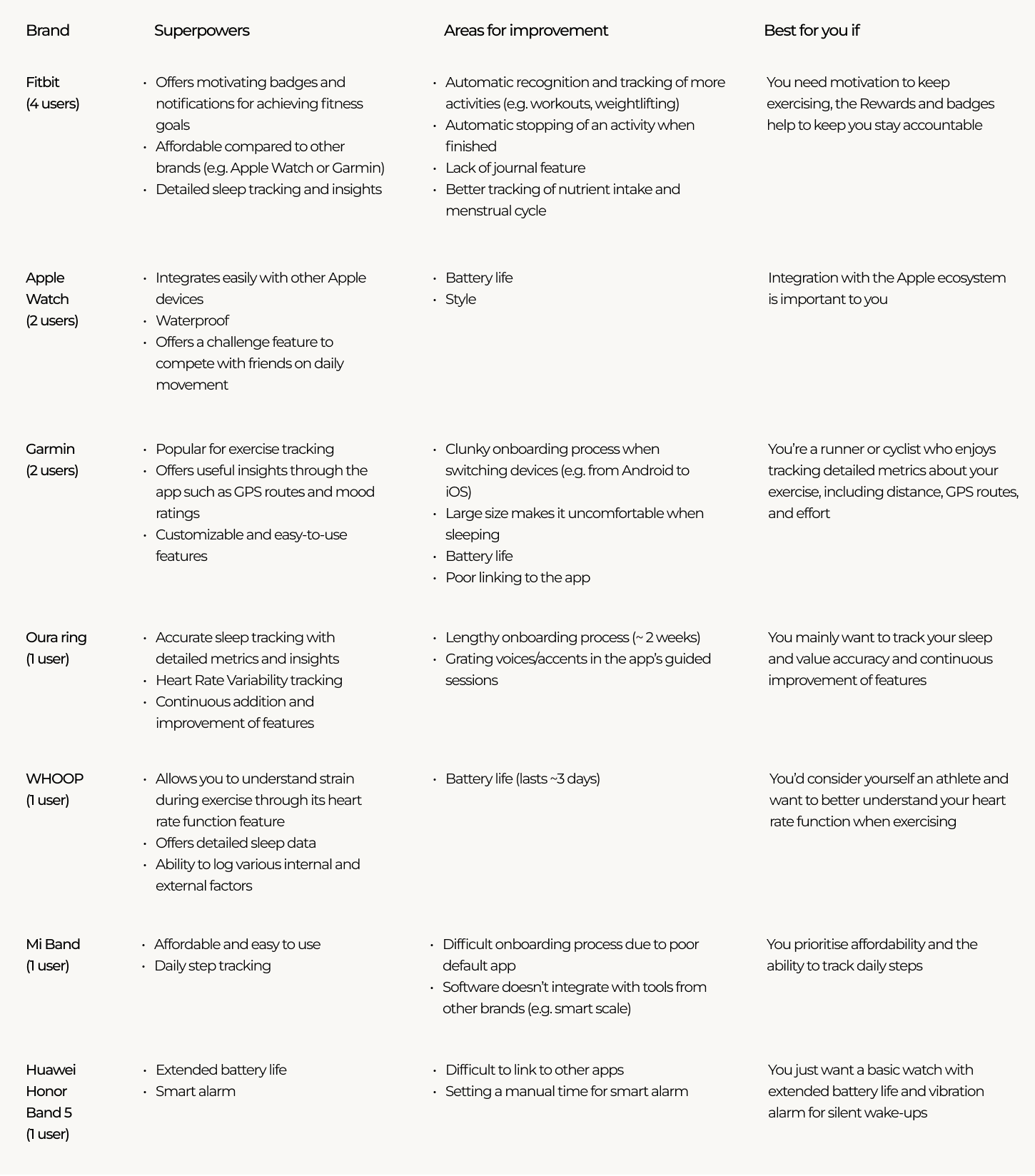Unleashing The Power Of Wearables: Can They Really Help You Achieve Your Life Goals? (Part 1)



As many of us have embraced the WFH life, taking care of our health and well-being has become more important than ever. We’re turning to wearable devices, such as Fitbits or Apple Watches, to help us track our progress towards our fitness goals. But the question remains: do these devices actually work in helping us maintain healthy habits?
At Spotless, user experience is central to everything we do. Returning after Christmas (woah, doesn’t that feel like ages ago?!), we discussed as a team our new year intentions and goals for the year, some of us already wearing wearables to track our progress on these. Curiosity got the better of us and our need to delve deeper into the UX of wearables stepped in…
Naturally, we asked 12 real users about their experience with wearable devices such as Fitbit, WHOOP, and Garmin, to find out how effective they really are in forming and sustaining new habits.
Read on for the highlights from this Discovery or head straight to our side-by-side comparison of all 7 devices used by our participants further down the page.
Wearable devices are more than just fancy accessories, they can potentially be life changing
We know it’s a big claim, but so far our users have described many ways their relationship with their wearable tech has helped them make positive changes in their life. Here’s some of the ways wearable devices can help you kickstart healthy habits and crush your fitness goals by providing motivation, accountability, and real-time tracking of important health & wellbeing metrics.

Hitting the track
Users originally purchased their wearable to track their exercise and health data to better understand their baseline, identify areas of improvement, and stay accountable to their fitness goals. Leading a healthier and more active lifestyle is the communal goal. Most users mentioned wanting to exercise more regularly, eat healthier, and improve their sleep patterns. A tool to help them stay on track and motivated was the first step in reaching that goal.
Unsurprisingly, the most commonly tracked metrics are steps and exercise. Some users enjoyed tracking their exercise and sleep, discovering a new sense of achievement and improved sleep quality. Tracking sleep and heart rate monitoring has shifted some mindsets towards valuing rest and recovery as much as movement and exercise.
“The step count and exercise is important now that I work from home 99.9% of the time. Not having a morning commute means my activity levels have dropped massively so daily movement is super important.” – Apple Watch user
“I like tracking my different stages of how I sleep and how that correlates with how rested I feel the next day.” – WHOOP user
Reaping the rewards (and badges!)
Users appreciated the motivational benefits of badges and other rewards provided by their devices (like the dopamine rush I get every time my Fitbit alerts me that I’ve achieved my daily step count!). They hoped that tracking their habits would help them stay consistent and motivated to reach their goals.
As one participant put it, “I’m expecting the Fitbit to make reaching exercise goals fun and help hold me accountable because you can visibly see on your wrist how much you have moved and what you have achieved, e.g. if I notice I haven’t done very many steps I get up and try and do more.” – Fitbit user
I can definitely relate to this user – whenever I’ve been sitting down for too long and I get a notification on my Fitbit I immediately know I need to move. Whether or not I listen to the prompt is another question…
Where should Developers focus their efforts in improving wearable technology?
Developers of wearable devices can continue to improve the user experience by addressing common concerns such as battery life and tracking accuracy, while also adding new features that cater to users’ needs and preferences. Here are some areas we feel shouldn’t be overlooked when it comes to wearable tech development…
A missed step with onboarding
Whilst getting set-up on the devices was relatively easy and straightforward, there seems to be a missed opportunity in inspiring and educating users around the potential of the product during the onboarding process, leaving some feeling like they could be getting more from their device (or more bang for their buck!)
“It didn’t come with very much information in the box so I feel like I am still learning how to use it properly. I sometimes wonder if I’m not using it to its full potential. There’s a lot of stuff that needs explaining.” – Fitbit user
“Initially the amount of possible data points can be a lot but it’s well explained.” – WHOOP user
Ultimate ecosystem integration is the goal
As was the case with our Apple watch users, being able to easily integrate their device with their other Apple devices was a major deciding factor when picking which wearable to buy and was valued highly throughout using their wearable.
Users wanted more software integration with different tools from other brands, as well as the addition of new features like a journal or more customisation options.
Users were pleased when their apps did speak to one another (e.g. My Fitness Pal and Flo with Fitbit) as this reduced the manual processes involved with tracking metrics such as food calories, steps and period tracking.
Battery life and manual tracking were a step back
Users most commonly wanted to improve battery life (especially for WHOOP and Garmin users), as well as better recognition and automatic tracking of activities. For example, while Fitbit automatically tracks whether you go for a walk or a cycle, it doesn’t recognise when you’re lifting weights or doing a workout, so users had to manually input these. What’s that about Fitbit?
“It also needs to get better at stopping the activity once you’ve finished automatically, or at least sending a notification ‘looks like you’ve finished your workout, stop tracking?’ as I often forget to pause and finish – I recorded an 8 hour workout last Friday! I don’t think I’ve ever spent longer than 2 hours at the gym.” – Fitbit user
Goal setting wasn’t hitting all the targets
Setting goals ensures a sense of accomplishment when these are reached; without anything to work towards users are likely disengaged.
Many users have set goals on their device, such as hitting a certain number of daily steps, a certain number of ‘active zone’ minutes in a week, or getting a certain amount of sleep per night. However, some users struggled to set goals outside the parameters of what the device can track, such as weight lifting targets or distance travelled. Some users could benefit from tracking progress across multiple different goals and seeing how these combined towards a specific wellness goal.
“…I do wish I could set and track progress against other goals I have, such as my drinking and eating habits more easily. I know you can connect my Fitness Pal but I’ve always found logging food and drink tedious, also I don’t agree with counting calories.” – Fitbit user
There is an opportunity to make goal setting across wearables a more rewarding experience. We reckon with some more intelligent data analysis in the reporting, alongside simple gamification with some personalised rewards thrown in the mix, users will be even more satisfied with their wearables. We make it sound so easy, but perhaps you are up for the challenge of making this a reality?
Some bonus ideas from our users!
Users had a variety of ideas for a device or app that could help them achieve their goals more effectively. Some wanted a more stylish and customisable wearable device, while others suggested an app that could help them wake up earlier or monitor nutrient intake and internal states. Others wanted an all-in-one app that catered to specific user types and goals, with a personalised experience based on their needs.
“Maybe a one stop shop app that has specific journeys or user types built into the app… creating a more personalised experience based on those goals, i.e. exposing the features that are most relevant to the user vs showing absolutely everything to everyone. Preferably one with good search functionality as well so that it’s easier to find what I need” – Mi Band user
So which wearable device would we recommend?
Well that all depends on your goals and priorities, but our brand comparison might be able to assist…
- A Fitbit is best for you if… You need motivation to keep exercising, the rewards and badges help to keep you stay accountable.
- An Apple Watch is for you if… Integration with the Apple ecosystem is important to you.
- A Garmin is best for you if… You’re a runner or cyclist who enjoys tracking detailed metrics about your exercise, including distance, GPS routes, and effort.
- An Oura ring is best for you if… You mainly want to track your sleep and value accuracy and continuous improvement of features.
- A WHOOP is best for you if… You’d consider yourself an athlete and want to better understand your heart rate function when exercising.
- A Mi Band is best for you if… You prioritise affordability and the ability to track daily steps.
- A Huawei Honor Band 5 is best for you if… You just want a basic watch with extended battery life and vibration alarm for silent wake-ups.
Brand comparison






Ben is on hand to answer your questions.


Please fill out the form below and we will get back to you as soon as possible. For jobs and work experience opportunities, please visit our careers page.

.jpg)

.jpg)
.png)


.svg)




.png)

